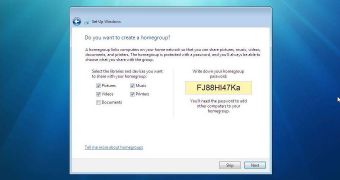Windows Home Server is not the sole operating system from Microsoft tailored to households with multiple machines. In fact, Windows 7, the next iteration of the Windows client, will bring to the table a feature that seemed buried with the transition from Longhorn to Windows Vista. In this context, Win7 will offer networking inside the home to the next level, compared to Windows Vista, through a feature labeled Castle in Longhorn.
Available among Windows 7 PCs, HomeGroup is set up to connect closely together the home computers, while at the same time stretching to additional devices such as Xbox 360 consoles and printers, enabling media and document sharing between all items in a home group. However, the first function of the feature is to automate and simplify the process of setting up a home network with all involved aspects, including user interface, sharing, media, printing, storage, search, etc.
“Windows Vista introduced a concept known as network location awareness (NLA). This enables the system to recognize when you’ve changed network locations, and it tags the location with a simple 'Home,' 'Work.' or 'Public' designation,” Jerry Koh, a lead program manager in the Core User Experience team, explained.
“In Windows 7, we extended the concept of NLA and made 'work' and 'home' more distinct. In Windows 7, when you select the 'home' network profile, we know that you are 'at home,' and will start the essential services required for successful file and printer sharing in the home. This provides an intuitive entry point into HomeGroup, and once you are 'at home' we start looking for (via network discovery) other Win7 PCs in the home.”
In order to provide data security for the machines in a HomeGroup, Windows 7 will auto-generate a password for a specific home network, and will only accept as members of the group those machines that offer the specific physical key. Koh indicated that Microsoft had found it much simpler to pre-generate passwords out of the box rather than let the users specify the keys, since they would have to be shared with all the existing users of the home group.
“In addition to balancing security with ease of use, we also wanted to account for PCs becoming more personal. For this reason, we adopted the concept that each person in the HomeGroup is a peer of the others. Each person can thus join and leave the HomeGroup as they wish. Each person brings with them their choice of media/memories or files to share with the rest of the home. With a system based on equals and peers, the big benefit is a lack of management overhead; you don’t need one person to bear the management task of maintaining the group and dealing with membership tasks. This eliminates a primary source of complexity. All you need to gain entry is the shared password (just like the house key that each family member has),” Koh added.
Windows 7's HomeGroup feature will work in conjunction with Libraries, which are designed to aggregate the shared content from multiple physical locations in a single spot. In this regard, a HomeGroup, and the content it has centralized, will be available not via network folders, but through Windows Explorer. At the same time, Microsoft has made sure that all the home-grouped content will be offered through Windows Media Player and Windows Media Center.
“In addition to sharing out your media by default, we also wanted to make sharing additional content to the HomeGroup simple. In the past you had to worry about setting access control, as well as managing user passwords to make sharing work in the home. As we better understood how people interacted and worked at home, we realized that most were OK with enabling general access to all members of the household. So, we built a few shortcuts into the sharing experience to enable this. Windows Explorer now features a new 'share with' menu in the command,” Koh explained.
Via a HomeGroup, Windows 7 will also play nice with printers, even with USB printers, Microsoft revealed. The promise is that in Windows 7 USB printers with the Windows logo will be installed automatically and just work across all machines in a HomeGroup. “They won’t see a prompt, they won’t need to answer any questions – it would just show up, and 'just work.' For non-Windows logoed printers, we need to ask the user for permission to install the printer,” Koh argued.
Windows 7 HomeGroup will also be sufficiently smart in order to tell the difference between content specific to domain-joined computers and home content, and share just the latter through HomeGroup. “Sensitive content on the corporate laptop is never shared to the other HomeGroup computers. In essence, the domain-joined computer can see out (and consume), but no one can see in,” Koh stated.

 14 DAY TRIAL //
14 DAY TRIAL //